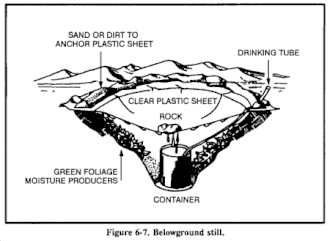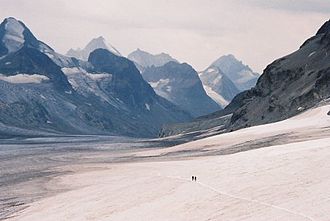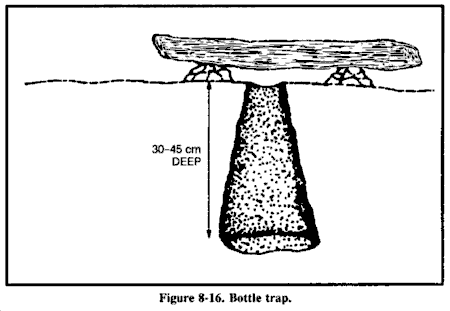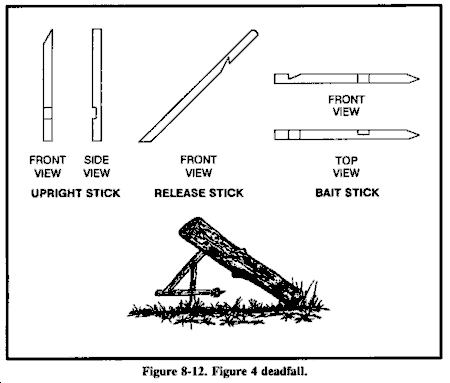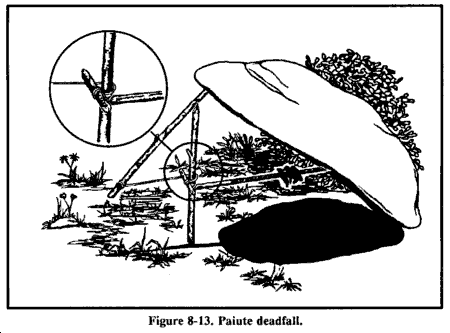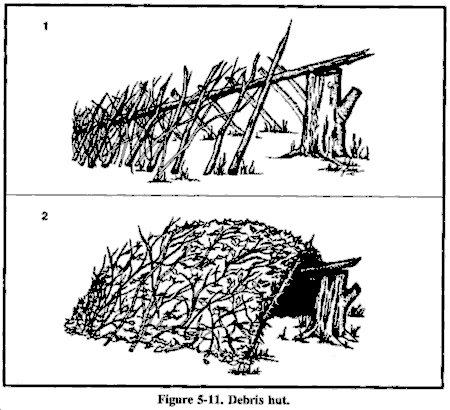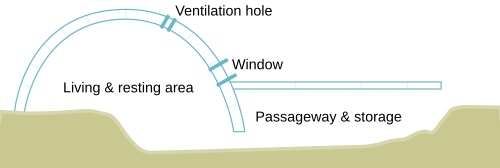AY Honors/Wilderness Leadership - Advanced/Answer Key
Skill Level
3
Year
1976
Version
12.01.2026
Approval authority
General Conference
1
For tips and instruction see Edible Wild Plants.
For tips and instruction see Outdoor Leadership.
For tips and instruction see Wilderness Leadership.
For tips and instruction see Wilderness Living.
2
In order to come close to an animal, trackers must remain undetected not only by the animal, but also by other animals that may alert it. Moving as quietly as possible, trackers will avoid stepping on dry leaves and twigs, and take great care when moving through dry grass.
If the trackers are in close proximity to the animal, it is important that they remain downwind of it, that is, in a position where the wind is blowing away from the animal in the direction of the tracker. They must never be in a position where their scent could be carried in the wind towards the animal and thereby alert it. It is also important that the animal does not have the opportunity to cross their tracks, since the lingering human scent will alert it. Most animals prefer to keep the wind in their faces when traveling so that they can scent danger ahead of them. Trackers will therefore usually be downwind from them as they approach the animals from behind. The wind direction may, however, have changed. If the wind direction is unfavorable, the trackers may have to leave the spoor (tracks and other indications of an animal's presence) to search for their quarry from the downwind side.
As the trackers get closer to the animal, they must make sure that they see it before it sees them. Some trackers maintain that an animal keeps looking back down its own trail, always on the alert for danger coming from behind. When the spoor is very fresh, trackers may have to leave the spoor so that the animal does not see them first. Animals usually rest facing downwind, so that they can see danger approaching from the downwind side, while they can smell danger coming from behind them. An animal may also double back on its spoor and circle downwind before settling down to rest. A predator following its trail will move past the resting animal on the upwind side before realizing that the animal had doubled back, and the resting animal will smell the predator in time to make its escape.
When stalking an animal, trackers use the cover of bushes, going down on their hands and knees where necessary. In long grass they go down on their stomachs pulling themselves forward with their elbows. The most important thing is not to attract attention by sudden movements. Trackers should take their time, moving slowly when the animal is not looking, and keeping still when the animal is looking in their direction. When stalking an animal, trackers must also be careful not to disturb other animals. A disturbed animal will give its alarm signal, thereby alerting all animals in the vicinity, including the animal being tracked down.
Text from The Art of Tracking: The Origin of Science, by Louis Liebenberg, with permission from the author. Taken from Wikipedia:Tracking (hunting)
3
Physical
Physical readiness not only implies physical fitness, but also the many things that have to be done to make the trip possible.
- Choose a destination.
- Evaluate what sort of equipment will be needed for the possible conditions (not just the likely ones).
- Let the participants know what equipment they will need.
- Gather the equipment you will need yourself.
- Gather the equipment needed by the group.
- Make sure that the participants have gathered the equipment they will need.
- Organize transportation (drop off and pick up if it is not a loop trip).
- Distribute medical release forms to all participants. Minors should have theirs signed by a legal guardian. The leader and alternate should have copies of these forms with them.
- Select a menu and buy food
- Pack!
Mental
Every participant must make mental preparations before leaving (not just the leader).
- Review a map of the area.
- Know where to get help if help is needed.
- Know the rules governing the area you are going.
- Check the weather forecast.
- Talk with the government officials responsible for the area where you will spend your time. Check in with them when you arrive and let them know your plans. Check with them again when you leave.
- Review First Aid principles
- Review Fire Safety
- Teach your group the things you have reviewed. If the only person who knows first aid is injured, who will administer first aid? Everyone should know what to do.
- Go over group safety principles.
- Appoint a leader and an alternate in case something happens to the leader.
- Work out any differences of opinion before departure.
- Understand the conditions that would make you turn back:
- Weather
- Injury or sickness
- Loss of equipment or supplies
4
4a
Immediate Considerations
Take shelter from tropical rain, sun, and insects. Malaria-carrying mosquitoes and other insects are immediate dangers, so protect yourself against bites.
In the tropics, even the smallest scratch can quickly become dangerously infected. Promptly treat any wound, no matter how minor.
Getting Water
- From Banana or Plantain Trees
- Wherever you find banana or plantain trees, you can get water. Cut down the tree, leaving about a 30-centimeter stump, and scoop out the center of the stump so that the hollow is bowl-shaped. Water from the roots will immediately start to fill the hollow. The first three fillings of water will be bitter, but succeeding fillings will be palatable. The stump will supply water for up to four days. Be sure to cover it to keep out insects.
- From Bamboo
- Green bamboo thickets are an excellent source of fresh water. Water from green bamboo is clear and odorless. To get the water, bend a green bamboo stalk, tie it down, and cut off the top. The water will drip freely during the night. Place a container directly below the cut top to collect the water as it drips. Old, cracked bamboo may contain water.
- From Streams and Lakes
- Often you can get nearly clear water from muddy streams or lakes by digging a hole in sandy soil about 1 meter from the bank. Water will seep into the hole. You must purify any water obtained in this manner.
Travel
With practice, movement through thick undergrowth and jungle can be done efficiently. Always wear long sleeves to avoid cuts and scratches.
To move easily, you must develop "jungle eye," that is, you should not concentrate on the pattern of bushes and trees to your immediate front. You must focus on the jungle further out and find natural breaks in the foliage. Look through the jungle, not at it. Stop and stoop down occasionally to look along the jungle floor. This action may reveal game trails that you can follow.
Stay alert and move slowly and steadily through dense forest or jungle. Stop periodically to listen and take your bearings. Use a machete to cut through dense vegetation, but do not cut unnecessarily or you will quickly wear yourself out. If using a machete, stroke upward when cutting vines to reduce noise because sound carries long distances in the jungle. Use a stick to part the vegetation. Using a stick will also help dislodge biting ants, spiders, or snakes. Do not grasp at brush or vines when climbing slopes; they may have irritating spines or sharp thorns.
Many jungle and forest animals follow game trails. These trails wind and cross, but frequently lead to water or clearings. Use these trails if they lead in your desired direction of travel.
4b
This section borrows heavily from the U.S. Army's FM21-76 Survival manual, which is in the public domain.
Intense sunlight and heat increase the body's need for water. To conserve your body fluids and energy, you will need a shelter to reduce your exposure to the heat of the day. Travel at night to lessen your use of water.
General Guidelines
Understanding how the air temperature and your physical activity affect your water requirements allows you to take measures to get the most from your water supply. These measures are--
- Find shade! Get out of the sun!
- Place something between you and the hot ground.
- Limit your movements!
- Conserve your sweat. Wear your complete uniform to include T-shirt. Roll the sleeves down, cover your head, and protect your neck with a scarf or similar item. These steps will protect your body from hot-blowing winds and the direct rays of the sun. Your clothing will absorb your sweat, keeping it against your skin so that you gain its full cooling effect. By staying in the shade quietly, fully clothed, not talking, keeping your mouth closed, and breathing through your nose, your water requirement for survival drops dramatically.
- If water is scarce, do not eat. Food requires water for digestion; therefore, eating food will use water that you need for cooling.
Thirst is not a reliable guide for your need for water. A person who uses thirst as a guide will drink only two-thirds of his daily water requirement. To prevent this "voluntary" dehydration, use the following guide:
- At temperatures below 38 degrees C, drink 0.5 liter of water every hour.
- At temperatures above 38 degrees C, drink 1 liter of water every hour.
Drinking water at regular intervals helps your body remain cool and decreases sweating. Even when your water supply is low, sipping water constantly will keep your body cooler and reduce water loss through sweating. Conserve your fluids by reducing activity during the heat of day. Do not ration your water! If you try to ration water, you stand a good chance of becoming a heat casualty.
Take extra care to avoid heat injuries. Rest during the day. Work during the cool evenings and nights. Use a buddy system to watch for heat injury, and observe the following guidelines:
- Make sure you tell someone where you are going and when you will return.
- Watch for signs of heat injury. If someone complains of tiredness or wanders away from the group, he may be a heat casualty.
- Drink water at least once an hour.
- Get in the shade when resting; do not lie directly on the ground.
- Do not take off your shirt and work during the day.
- Check the color of your urine. A light color means you are drinking enough water, a dark color means you need to drink more.
Getting Water
To make a belowground still, you need a digging tool, a container, a clear plastic sheet, a drinking tube, and a rock.
Select a site where you believe the soil will contain moisture (such as a dry stream bed or a low spot where rainwater has collected). The soil at this site should be easy to dig, and sunlight must hit the site most of the day.
To construct the still--
- Dig a bowl-shaped hole about 1 meter across and 60 centimeters deep.
- Dig a sump in the center of the hole. The sump's depth and perimeter will depend on the size of the container that you have to place in it. The bottom of the sump should allow the container to stand upright.
- Anchor the tubing to the container's bottom by forming a loose overhand knot in the tubing.
- Place the container upright in the sump.
- Extend the unanchored end of the tubing up, over, and beyond the lip of the hole.
- Place the plastic sheet over the hole, covering its edges with soil to hold it in place.
- Place a rock in the center of the plastic sheet.
- Lower the plastic sheet into the hole until it is about 40 centimeters below ground level. It now forms an inverted cone with the rock at its apex. Make sure that the cone's apex is directly over your container. Also make sure the plastic cone does not touch the sides of the hole because the earth will absorb the condensed water.
- Put more soil on the edges of the plastic to hold it securely in place and to prevent the loss of moisture.
- Plug the tube when not in use so that the moisture will not evaporate.
You can drink water without disturbing the still by using the tube as a straw.
You may want to use plants in the hole as a moisture source. If so, dig out additional soil from the sides of the hole to form a slope on which to place the plants. Then proceed as above.
If polluted water is your only moisture source, dig a small trough outside the hole about 25 centimeters from the still's lip (Figure 6-8). Dig the trough about 25 centimeters deep and 8 centimeters wide. Pour the polluted water in the trough. Be sure you do not spill any polluted water around the rim of the hole where the plastic sheet touches the soil. The trough holds the polluted water and the soil filters it as the still draws it. The water then condenses on the plastic and drains into the container. This process works extremely well when your only water source is salt water.
You will need at least three stills to meet your individual daily water intake needs.
4c
Saltwater Swamps
Saltwater swamps are common in coastal areas subject to tidal flooding. Mangrove trees thrive in these swamps. Mangrove trees can reach heights of 12 meters, and their tangled roots are an obstacle to movement. Visibility in this type of swamp is poor, and movement is extremely difficult. Sometimes, streams that you can raft form channels, but you usually must travel on foot through this swamp.
You find saltwater swamps in West Africa, Madagascar, Malaysia, the Pacific islands, Central and South America, and at the mouth of the Ganges River in India. The swamps at the mouths of the Orinoco and Amazon rivers and rivers of Guyana consist of mud and trees that offer little shade. Tides in saltwater swamps can vary as much as 12 meters.
Everything in a saltwater swamp may appear hostile to you, from leeches and insects to crocodiles and caimans. Avoid the dangerous animals in this swamp.
Avoid this swamp altogether if you can. If there are water channels through it, you may be able to use a raft to escape.
Freshwater Swamps
You find freshwater swamps in low-lying inland areas. Their characteristics are masses of thorny undergrowth, reeds, grasses, and occasional short palms that reduce visibility and make travel difficult. There are often islands that dot these swamps, allowing you to get out of the water. Wildlife is abundant in these swamps.
Swamp Bed
In a marsh or swamp, or any area with standing water or continually wet ground, the swamp bed keeps you out of the water. When selecting such a site, consider the weather, wind, tides, and available materials.
To make a swamp bed--
- Look for four trees clustered in a rectangle, or cut four poles (bamboo is ideal) and drive them firmly into the ground so they form a rectangle. They should be far enough apart and strong enough to support your height and weight, to include equipment.
- Cut two poles that span the width of the rectangle. They, too, must be strong enough to support your weight.
- Secure these two poles to the trees (or poles). Be sure they are high enough above the ground or water to allow for tides and high water.
- Cut additional poles that span the rectangle's length. Lay them across the two side poles, and secure them.
- Cover the top of the bed frame with broad leaves or grass to form a soft sleeping surface.
- Build a fire pad by laying clay, silt, or mud on one comer of the swamp bed and allow it to dry.
Another shelter designed to get you above and out of the water or wet ground uses the same rectangular configuration as the swamp bed. You very simply lay sticks and branches lengthwise on the inside of the trees (or poles) until there is enough material to raise the sleeping surface above the water level.
4d
Falling rocks
Every rock mountain is slowly disintegrating due to erosion, the process being especially rapid above the snow-line. Rock faces are constantly swept by falling stones, which may be possible to dodge. Falling rocks tend to form furrows in a mountain face, and these furrows (couloirs) have to be ascended with caution, their sides often being safe when the middle is stoneswept. Rocks fall more frequently on some days than on others, according to the recent weather. Ice formed during the night may temporarily bind rocks to the face but warmth of the day or lubricating water from melting snow or rain may easily dislodge these rocks. Local experience is a valuable help on determining typical rockfall on such routes.
The direction of the dip of rock strata sometimes determines the degree of danger on a particular face; the character of the rock must also be considered. Where stones fall frequently debris will be found below, while on snow slopes falling stones cut furrows visible from a great distance. In planning an ascent of a new peak or an unfamiliar route, mountaineers must look for such traces. When falling stones get mixed in considerable quantity with slushy snow or water a mud avalanche is formed (common in the Himalaya). It is vital to avoid camping in their possible line of fall.
Falling ice
The places where ice may fall can always be determined beforehand. It falls in the broken parts of glaciers (seracs) and from overhanging cornices formed on the crests of narrow ridges. Large icicles are often formed on steep rock faces, and these fall frequently in fine weather following cold and stormy days. They have to be avoided like falling stones. Seracs are slow in formation, and slow in arriving (by glacier motion) at a condition of unstable equilibrium. They generally fall in or just after the hottest part of the day. A skillful and experienced ice-man will usually devise a safe route through a most intricate ice-fall, but such places should be avoided in the afternoon of a hot day. Hanging glaciers (i.e. glaciers perched on steep slopes) often discharge themselves over steep rock-faces, the snout breaking off at intervals. They can always be detected by their debris below. Their track should be avoided.
Falls from rocks
The skill of a rock climber is shown by one's choice of handhold and foothold, and their adhesion to those once they have chosen. Much depends on a correct estimate of the firmness of the rock where weight is to be thrown upon it. Many loose rocks are quite firm enough to bear a person's weight, but experience is needed to know which can be trusted, and skill is required in transferring the weight to them without jerking. On rotten rocks the rope must be handled with special care, lest it should dislodge loose stones on to those below. Similar care must be given to handholds and footholds, for the same reason. When a horizontal traverse has to be made across very difficult rocks, a dangerous situation may arise unless at both ends of the traverse there are firm positions. Mutual assistance on hard rocks takes all manner of forms: two, or even three, people climbing on one another's shoulders, or using an ice axe propped up by others for a foothold. The great principle is that of co-operation, all the members of the party climbing with reference to the others, and not as independent units; each when moving must know what the climber in front and the one behind are doing. After bad weather steep rocks are often found covered with a veneer of ice (verglas), which may even render them inaccessible. Crampons are useful on such occasions.
Avalanches
The avalanche is the most underestimated danger in the mountains. People generally think that they will be able to recognize the hazards and survive being caught. The truth is a somewhat different story. Every year, 120 - 150 people die in small avalanches in the Alps alone. The vast majority are reasonably experienced male skiers aged 20–35 but also include ski instructors and guides. There is always a lot of pressure to risk a snow crossing. Turning back takes a lot of extra time and effort, supreme leadership, and most importantly there seldom is an avalanche to prove the right decision was made. Making the decision to turn around is especially hard if others are crossing the slope, but the next person could become the trigger.
Dangerous slides are most likely to occur on the same slopes preferred by many skiers: long and wide open, few trees or large rocks, 30 to 45 degrees of angle, large load of fresh snow, soon after a big storm, on a slope 'lee to the storm'. Solar radiation can trigger slides as well. These will typically be a point release or wet slough type of avalanche. The added weight of the wet slide can trigger a slab avalanche. Ninety percent of reported victims are caught in avalanches triggered by themselves or others in their group.
When going off-piste or travelling in alpine terrain, parties are advised to always carry:
- avalanche beacon
- probe
- shovel (retrieving victims with a shovel instead of your hands is five times faster)
It is also important to have had avalanche training! Paradoxically, expert skiers who have avalanche training make up a large percentage of avalanche fatalities; perhaps because they are the ones more likely to ski in areas prone to avalanches, and certainly because most people do not practice enough with their equipment to be truly fast and efficient rescuers.
Even with proper rescue equipment and training, there is a one-in-five chance of dying if caught in a significant avalanche, and only a 50/50 chance of being found alive if buried more than a few minutes. The best solution is to learn how to avoid risky conditions.
Ice slopes
For travel on slopes consisting of ice or hard snow, crampons are a standard part of a mountaineer's equipment. While step-cutting can sometimes be used on snow slopes of moderate angle, this can be a slow and tiring process, which does not provide the higher security of crampons. However, in soft snow or powder, crampons are easily hampered by balling of snow, which reduces their effectiveness. In either case, an ice axe not only assists with balance but provides the climber with the possibility of self-arrest in case of a slip or fall. On a true ice slope however, an ice axe is rarely able to effect a self-arrest. As an additional safety precaution on steep ice slopes, the climbing rope is attached to ice screws buried into the ice.
True ice slopes are rare in Europe, though common in mountains in the tropics, where newly-fallen snow quickly thaws on the surface and becomes sodden below, so that the next night's frost turns the whole mass into a sheet of semi-solid ice.
Snow slopes
Snow slopes are very common, and usually easy to ascend. At the foot of a snow or ice slope is generally a big crevasse, called a bergschrund, where the final slope of the mountain rises from a snow-field or glacier. Such bergschrunds are generally too wide to be stepped across, and must be crossed by a snow bridge, which needs careful testing and a painstaking use of the rope. A steep snow slope in bad condition may be dangerous, as the whole body of snow may start as an avalanche. Such slopes are less dangerous if ascended directly, rather than obliquely, for an oblique or horizontal track cuts them across and facilitates movement of the mass. New snow lying on ice is especially dangerous. Experience is needed for deciding on the advisability of advancing over snow in doubtful condition. Snow on rocks is usually rotten unless it is thick; snow on snow is likely to be sound. A day or two of fine weather will usually bring new snow into sound condition. Snow cannot lie at a very steep angle, though it often deceives the eye as to its slope. Snow slopes seldom exceed 40°. Ice slopes may be much steeper. Snow slopes in early morning are usually hard and safe, but the same in the afternoon are quite soft and possibly dangerous; hence the advantage of an early start.
Crevasses
Crevasses are the slits or deep chasms formed in the substance of a glacier as it passes over an uneven bed. They may be open or hidden. In the lower part of a glacier the crevasses are open. Above the snow-line they are frequently hidden by arched-over accumulations of winter snow. The detection of hidden crevasses requires care and experience. After a fresh fall of snow they can only be detected by sounding with the pole of the ice axe, or by looking to right and left where the open extension of a partially hidden crevasse may be obvious. The safeguard against accident is the rope, and no one should ever cross a snow-covered glacier unless roped to one, or even better to two companions. Anyone venturing onto crevasses should be trained in crevasse rescue.
Weather
The primary dangers caused by bad weather centre around the changes it causes in snow and rock conditions, making movement suddenly much more arduous and hazardous than under normal circumstances. Whiteouts make it difficult to retrace a route while rain may prevent taking the easiest line only determined as such under dry conditions. In a storm the mountaineer who uses a compass for guidance has a great advantage over a merely empirical observer. In large snow-fields it is, of course, easier to go wrong than on rocks, but intelligence and experience are the best guides in safely navigating objective hazards.
Summer thunderstorms may produce intense lightning. If a climber happens to be standing on or near the summit, they risk being struck. There are many cases where people have been struck by lightning while climbing mountains. In most mountainous regions, local storms develop by late morning and early afternoon. Many climbers will get an "alpine start"; that is before or by first light so as to be on the way down when storms are intensifying in activity and lightning and other weather hazards are a distinct threat to safety. High winds can speed the onset of hypothermia, as well as damage equipment such as tents used for shelter. Under certain conditions, storms can also create waterfalls which can slow or stop climbing progress. A notable example is the "Foen" wind acting upon the Eiger.
Altitude
Rapid ascent can lead to altitude sickness. The best treatment is to descend immediately. The climber's motto at high altitude is "climb high, sleep low", referring to the regimen of climbing higher to acclimatize but returning to lower elevation to sleep.
Common symptoms of altitude sickness include severe headache, sleep problems, nausea, lack of appetite, lethargy and body ache. Mountain sickness may progress to HACE (High Altitude Cerebral Edema) and HAPE (High Altitude Pulmonary Edema), both of which can be fatal within 24 hours.
In high mountains, atmospheric pressure is lower and this means that less oxygen is available to breathe. This is the underlying cause of altitude sickness. Everyone needs to acclimatize, even exceptional mountaineers that have been to high altitude before. Generally speaking, mountaineers start using bottled oxygen when they climb above 7,000 m. Exceptional mountaineers have climbed 8000-meter peaks (including Everest) without oxygen, almost always with a carefully planned program of acclimatization.
4e
Snow Blindness
The reflection of the sun's ultraviolet rays off a snow-covered area causes this condition. The symptoms of snow blindness are a sensation of grit in the eyes, pain in and over the eyes that increases with eyeball movement, red and teary eyes, and a headache that intensifies with continued exposure to light. Prolonged exposure to these rays can result in permanent eye damage. To treat snow blindness, bandage your eyes until the symptoms disappear.
You can prevent snow blindness by wearing sunglasses. If you don't have sunglasses, improvise. Cut slits in a piece of cardboard, thin wood, tree bark, or other available material. Putting soot under your eyes will help reduce shine and glare.
Fire
Dried moss, grass, and scrub willow are other materials you can use for fuel. These are usually plentiful near streams in tundras (open, treeless plains). By bundling or twisting grasses or other scrub vegetation to form a large, solid mass, you will have a slower burning, more productive fuel.
Warm Clothing
Dress in layers and avoid cotton. Wool or synthetics are warm even when wet, but when cotton gets wet (even from sweat), it effectively conducts heat away from the body. Wear a waterproof outer layer. If you find you are beginning to sweat, remove a layer of clothing or vent it. It is common for a person carrying a heavy load or doing heavy work (such as with an ax or shovel) to sweat even on a very cold day. Keep adjusting your layers until you quit sweating, as you do not want to be wet. When the exertion comes to an end, sweat-soaked clothing will quickly chill you.
Travel
Travelling in the snow is in many ways easier than travelling over solid ground if you have the right equipment. Snow shoes will keep you from sinking into the snow making it far easier to walk. Skis will speed you along even faster. Load your equipment on a sled and pull it along behind you. In this way you can carry far more equipment (or small children) than you could with a backpack.
4f
Fire
Small fires are better than large ones as they require less fuel and make less smoke. Sit close. Less fuel means less work in gathering fuel. Review the answers in Camping Skills IV to refresh yourself on how to build a fire in wet weather.
Water
When travelling for extended periods of time in the wilderness, it is not practical to carry all the water you will need. Happily, it is not necessary to do that either if you know how to make the water that is available suitable for drinking. There are generally three ways to purify water: chemically, by boiling, or by filtering. The most reliable method of purifying water is by pumping it through a filter. Chemically treating the water is also easy and convenient until you run out of purification tablets. Boiling water requires that you stop long enough to build a fire and bring the water to a boil. Then you are faced with the problem of carrying boiling water. For these reasons, filtering is the preferred solution. Be sure to refill when water is available, and think ahead to when water may not be plentiful (such as near the summit of a large hill or mountain), and make adequate preparations.
Bear Danger
Bear danger is the risk encountered by humans while interacting with wild bears.
Although some bears are alpha predators in their own habitat, they do not, under normal circumstances, hunt and feed on animals of their own size (including humans). Therefore, the most important cases of bear attack occur when the animal is defending itself against any possible threat. For instance, bear sows can become extremely aggressive if they feel their cubs are threatened. Any solitary bear is also likely to become agitated if surprised or cornered by a threat maker, especially while eating.
- Dealing with bear encounters
Before backpackers are allowed to enter an area with bears, they may be required to watch a video that teaches how to avoid encountering or agitating bears. Experts emphasize keeping your distance and making noise to avoid startling a bear as the best ways to avoid a bear attack. If a bear does become confrontational, the usual advice is to raise the arms above the head so as to appear larger, and to yell at the bear. Running away can activate the bear's hunting instincts and lead to it perceiving the human as prey. If a bear does charge, persons are advised to hold their ground, as most bear charges are bluffs. Finally, if a bear does attack, the usual advice is to curl into a fetal position so as to shield vital organs and appear non-threatening. If this is not effective in stopping the attack, the only option left is to fight the bear in any way you can. The ideal place to punch a bear is the snout or eyes. This advice applies to omnivores such as brown and black bears; the best way to avoid being attacked by the completely carnivorous polar bear is not to enter any area where polar bears live, or at least remain inside a hard-shell vehicle or building.
- Food storage and garbage disposal
Bears have an excellent sense of smell, and are attracted to human and pet foods as well as refuse. Improper storage of these items can allow bears to eat human food and become dependent on it, increasing the probability of encounters with humans. Most brown and black bear encounters in human-populated areas involve so-called "trouble bears", usually young males who have just left their mothers and do not yet have a territory of their own. If they wander close to human settlements, the smells of cooking and garbage can cause them to ignore their usual instinct to avoid humans. Many parks and persons in areas with bears utilize bear-resistant garbage cans and dumpsters for this reason, and many areas have laws prohibiting the feeding of bears, even if unintentional. Campers can access bear-proof containers from many parks to store their food and trash. The containers are then buried or strung on a rope between two tall trees, out of bears' reach. They are also instructed to put their containers, campfire, and tenting 90 meters ![]() away from each other, forming a triangle.
away from each other, forming a triangle.
5
These traps and their descriptions were taken from the U.S. Army Field Manual, No. 21-76, Survival. Note that for the purpose of practicing the building of these traps, the two deadfalls can be rendered harmless by replacing the heavy weight with a basket. Any animal will then be caught unharmed, allowing you to release it.
Bottle Trap
A bottle trap is a simple trap for mice and voles (Figure 8-16). Dig a hole 30 to 45 centimeters deep that is wider at the bottom than at the top. Make the top of the hole as small as possible. Place a piece of bark or wood over the hole with small stones under it to hold it up 2.5 to 5 centimeters off the ground. Mice or voles will hide under the cover to escape danger and fall into the hole. They cannot climb out because of the wall's backward slope. Use caution when checking this trap; it is an excellent hiding place for snakes.
Figure 4 Deadfall
The figure 4 is a trigger used to drop a weight onto a prey and crush it (Figure 8-12). The type of weight used may vary, but it should be heavy enough to kill or incapacitate the prey immediately. Construct the figure 4 using three notched sticks. These notches hold the sticks together in a figure 4 pattern when under tension. Practice making this trigger before-hand; it requires close tolerances and precise angles in its construction.
Paiute Deadfall
The Paiute deadfall is similar to the figure 4 but uses a piece of cordage and a catch stick (Figure 8-13). It has the advantage of being easier to set than the figure 4. Tie one end of a piece of cordage to the lower end of the diagonal stick. Tie the other end of the cordage to another stick about 5 centimeters long. This 5-centimeter stick is the catch stick. Bring the cord halfway around the vertical stick with the catch stick at a 90-degree angle. Place the bait stick with one end against the drop weight, or a peg driven into the ground, and the other against the catch stick. When a prey disturbs the bait stick, it falls free, releasing the catch stick. As the diagonal stick flies up, the weight falls, crushing the prey.
6
6a
When travelling over glaciers, crevasses pose a grave danger. These giant cracks in the ice are not always visible as snow can be blown and freeze over the top to make a snowbridge. At times snowbridges can be as thin as a few inches. Climbers use a system of ropes to protect themselves from such hazards. Basic gear for glacier travel includes crampons and ice axes. Teams of two to five climbers tie into a rope equally spaced. If a climber begins to fall the other members of the team perform a self-arrest to stop the fall. The other members of the team enact a crevasse rescue to pull the fallen climber from the crevasse.
6b
Dangers in mountaineering are sometimes divided into two categories: objective hazards that exist without regard to the climber's presence, like rockfall, avalanches and inclement weather, and subjective hazards that relate only to factors introduced by the climber. Equipment failure and falls due to inattention, fatigue or inadequate technique are examples of subjective hazard. A route continually swept by avalanches and storms is said to have a high level of objective danger, whereas a technically far more difficult route that is relatively safe from these dangers may be regarded as objectively safer.
In all, mountaineers must concern themselves with dangers: falling rocks, falling ice, snow-avalanches, the climber falling, falls from ice slopes, falls down snow slopes, falls into crevasses and the dangers from altitude and weather. To select and follow a route using one's skills and experience to mitigate these dangers is to exercise the climber's craft.
6c
Compacted snow conditions allow one to progress on foot. Frequently crampons are required to travel efficiently over snow and ice. Crampons have 8-14 spikes and are attached to a mountaineer's boots. They are used on hard snow (neve) and ice to provide additional traction and allow very steep ascents and descents. Varieties range from lightweight aluminum models intended for walking on snow covered glaciers, to aggressive steel models intended for vertical and overhanging ice and rock. Snowshoes can be used to walk through deep snow. Skis can be used everywhere snowshoes can and also in steeper, more alpine landscapes, although it takes considerable practice to develop strong skills for difficult terrain.
6d
Water travel means travelling by means of some sort of boat, be it a sailboat, motorboat, rowboat, canoe, or kayak. In all cases, it is important that every person have access to a Personal Flotation Device (PFD), also known as a life jacket. See the answers to the following honors for more information:
7
The wilderness, though filled with beauty, is an inherently dangerous place. The dangers presented by the wilderness come in many forms, including wild animals, weather, flash flooding, injuries, falls from high places, falling trees, etc. This list could extend for many pages. Compounding these dangers is the fact that any incidents which require medical attention will have to be dealt with long before a victim can be transported to a hospital. So while it is important that one's skills match the situations likely to be encountered, it is also important that the leader stay in touch with The Almighty.
Get in the habit of communing with Him on a regular basis. Consult Him on all major decisions. But most of all, understand that He will be with you as you face any danger. For he will command his angels concerning you to guard you in all your ways. - Psalm 91:11, NIV.
8
The survival of the wilderness is threatened by man. Our continual overuse of resources drives people to clear forests at a rate much faster than they can regrow. The best protection the wilderness has is that we change our lifestyles so that they are sustainable. Try walking or riding a bike instead of jumping mindlessly into the car. Buy a fuel-efficient car instead of a gas-guzzler. Learn how to repair things instead of throwing them away and replacing them (this is a lot easier when you buy quality items rather than "disposable" ones). Pay attention to how the things you consume are made. Remember that it takes more energy to feed corn to beef cattle than it does for you to eat the corn yourself. By controlling consumption, we can slow the rate at which the wilderness disappears.
Many governments have recognized this problem and have responded by setting aside protected wilderness areas. These are the areas you are likely to enjoy when you engage in the activities outlined in this honor, so it is imperative that you do everything you can to preserve them. Wilderness lovers frequently quote two mottoes related to the preservation of the wilderness. The first is "Take only pictures, leave only footprints." The second is "Pack in, pack out." The first of these is covered sufficiently in the Camping Skills honors that lead up to this one, so we will not rehash it here. The second relates to the practice of not leaving anything in the wilderness that you brought in with you. There are many old (and out-of-date) woodcraft guides that advise burning your trash, and burying what you cannot burn. Modern practice dictates that if you had the space in your pack to bring your trash into the wilderness with you, you will also have room in your pack to bring right back out. Do not leave your trash behind.
9
- Backpacking
- Camping Skills I
- Camping Skills II
- Camping Skills III
- Camping Skills IV
- Fire Building & Camp Cookery
- First Aid
- Hiking
- Orienteering
10
Debris Hut
These instructions for making a debris hut were taken from U.S. Army Field Manual, No. 21-76, Survival.
For warmth and ease of construction, this shelter is one of the best. When shelter is essential to survival, build this shelter.
To make a debris hut:
- Build it by making a tripod with two short stakes and a long ridgepole or by placing one end of a long ridgepole on top of a sturdy base.
- Secure the ridgepole (pole running the length of the shelter) using the tripod method or by anchoring it to a tree at about waist height.
- Prop large sticks along both sides of the ridgepole to create a wedge-shaped ribbing effect. Ensure the ribbing is wide enough to accommodate your body and steep enough to shed moisture.
- Place finer sticks and brush crosswise on the ribbing. These form a latticework that will keep the insulating material (grass, pine needles, leaves) from falling through the ribbing into the sleeping area.
- Add light, dry, if possible, soft debris over the ribbing until the insulating material is at least 1 meter thick--the thicker the better.
- Place a 30-centimeter layer of insulating material inside the shelter.
- At the entrance, pile insulating material that you can drag to you once inside the shelter to close the entrance or build a door.
- As a final step in constructing this shelter, add shingling material or branches on top of the debris layer to prevent the insulating material from blowing away in a storm.
Snow Shelters
Another option is to build an igloo, build a snow fort, hollow out a snow drift, or build a Quinzhee (which is made by first making a pile of snow, and then hollowing it out). All of these require a considerable expenditure of energy, and it is imperative that the workers not soak their clothing with sweat while working. If you find you are sweating, remove a layer or two.
When referring to a snowhouse, igloos are shelters constructed from blocks of snow, generally in the form of a dome. Although igloos are usually associated with all Inuit, they were predominantly constructed by people of Canada's Central Arctic and Greenland's Thule area. Other Inuit people tended to use snow to insulate their houses which consisted of whalebone and hides. Snow was used because the air pockets trapped in it make it an insulator. On the outside, temperatures may be as low as −45 °C (−49.0 °F), but on the inside the temperature may range from −7 °C (19 °F) to 16 °C (61 °F) when warmed by body heat alone.
The snow for a quinzhee need not be of the same quality as required for an igloo. Quinzhees are not usually meant as a form of permanent shelter, while igloos can be used for seasonal and year round habitation. The construction of a quinzhee is slightly easier than the construction of an igloo, although the overall result is somewhat less sturdy and more prone to collapsing in harsh weather conditions. Quinzhees are normally constructed in times of necessity, usually as an instrument of survival, so aesthetic and long-term dwelling considerations are normally exchanged for economy of time and materials.
To build a quinzhee, begin by making a large pile of snow about 2 meters![]() high, and 3 meters
high, and 3 meters![]() in diameter. You can optionally start the pile with large, easily removed items, such as a couple of backpacks. This will make it easier to hollow out the pile, but if you find yourself in need of something in your pack before the pack has been freed, you will have to wait. Once the pile has been built, let it set for an hour or two. This allows the snow to undergo a process called sintering which binds the ice crystals together. Before you begin hollowing it out though, find several sticks 20-30 cm
in diameter. You can optionally start the pile with large, easily removed items, such as a couple of backpacks. This will make it easier to hollow out the pile, but if you find yourself in need of something in your pack before the pack has been freed, you will have to wait. Once the pile has been built, let it set for an hour or two. This allows the snow to undergo a process called sintering which binds the ice crystals together. Before you begin hollowing it out though, find several sticks 20-30 cm![]() long. Break them until they are all the same length, then jam them straight into the pile until they disappear. These will help you gauge the thickness of the walls as you hollow out the center. Then, using a shovel, start removing snow. Dig a tunnel first, then enlarge it. Stop digging in an area when you find one of the gauge sticks inserted previously. The last step it to create a couple of ventilation holes. These should be small tunnels about 5 cm
long. Break them until they are all the same length, then jam them straight into the pile until they disappear. These will help you gauge the thickness of the walls as you hollow out the center. Then, using a shovel, start removing snow. Dig a tunnel first, then enlarge it. Stop digging in an area when you find one of the gauge sticks inserted previously. The last step it to create a couple of ventilation holes. These should be small tunnels about 5 cm![]() in diameter, positioned not at the top of the quinzhee, but not far from it either.
in diameter, positioned not at the top of the quinzhee, but not far from it either.
In any of these structures, it is important to make the resting area higher than the floor. This is because cold air sinks, so the coldest place inside a snow shelter will be on the floor.
11
This is where all that knowledge is put to use. Wilderness camping is different from "camp ground" camping and offers the Pathfinder many opportunities to practice group dynamics, responsibility, and build self-confidence. A well-organized trip is a joy to experience, whereas an ill-organized one can be a seemingly unending series of mishaps and misery.
As the leader, it is important that you do not do all the doing. The other participants will feel that they are merely so much luggage and begin to act as if they have no responsibilities. One of the most difficult lessons I have learned as a leader is that a leader should really step back and lead rather than jump in and do. When doing instead of leading, it is too easy to become absorbed in the task at hand and lose track of the overall picture. While you're busy doing, other people finish (or abandon) their tasks, and you're too busy to give them their next assignment. Rather, you as the leader should direct the activities of the others. Know what needs to be done next, and assign someone to do it. If they are having trouble, help them, but do not take over. If helping them becomes too involved, assign someone else to help them.
A highly effective way of doing this is to make a set of cards describing each task that needs to be done when setting up (or breaking) camp. Each task should be doable by a team of three or four kids with advice and guidance from an adult mentor. Sort the tasks into groups by priority, so that the things that must be done first are in one group, the things that should be done second are in another, and things that should be done last are in the third group. Label these groups A, B, and C. The number of tasks in each group should be equal to the number of 3-5 person teams that will be camping with you. Do not include pitching the sleeping tents in this list of tasks (more on that later).
Each card should also be marked with "points" to be awarded to the team who completes that task. Difficult, lengthy or unpleasant tasks should be worth many points. Easy, quick and fun tasks should be awarded few points.
Before you leave for your trip, assemble the kids into teams and assign to each team an adult mentor. Each team should have a mix of kids - some who are experienced or skilled, and some who are inexperienced or have not yet developed camping skills.
Choose the teams wisely. Best friends have a tendency to goof off. When I was a teen, my brother and I had been hired by an uncle to do some farm work. When we suggested that he should also hire our other brother, he responded with this gem that I will never forget:
- "A boy's a boy, two boys are half a boy, and three boys is no boy at all."
I understand that far better now than I did when he said it. Knowing about this tendency will enable you to head it off so you don't have to work against it. Assign juniors to teens, and assign teens to adult mentors. Go over this with the teens ahead of time so that they will have an idea of what they are to teach the juniors to do as they do it. This will not only introduce the juniors to new knowledge, but it will reinforce it in your teens.
When you arrive at your camp site, instruct all Pathfinders to pitch the tents they will sleep in, and then stow their sleeping bags and personal gear in them. When they are finished with that, have them assemble near the remaining equipment. As soon as a complete team has finished pitching their tents and stowing their gear, they may choose one of the A tasks. When they finish their A task to their mentor's satisfaction, they may choose a B task. When they finish their B task, they may choose a C task. When they finish their C task, they may choose another C task if one is available (and thereby improve their point total).
Be sure to let your Pathfinders know how the points will be used ahead of time, otherwise they will not serve as an effective incentive. You could award the team with the highest number of points the privilege of being dismissed to eat first, followed by the team with the second highest number of points, etc. Console the team scoring the fewest number of points by reminding them that the staff actually eats last.
When we implemented this plan in my club we found that it made a remarkable difference in getting the kids motivated and focused on setting up the camp site. Instead of finding kids to do the tasks I was coming up with on the spot, the kids were coming to me for their assignments. Instead of goofing around and doing a poor job, they were executing their duties with enthusiasm and efficiency, and upon completion, they were eager to take on the next task.
To give you an idea of what tasks might be described on the cards, the tasks we used are listed below. Though the tasks below are suited more for "Campground camping" rather than "wilderness camping", they still give a general picture of what is to be done. Not all of these tasks are required at every camp out.
| A Tasks | Pitch kitchen shelter 10 points |
Pitch dining shelter 10 points |
Build latrine 8 points |
Sort camp chairs 5 points |
|---|---|---|---|---|
| B Tasks | Set up tables (1 point/table) | Set up hygiene stations[1] 4 points |
Prepare dishes[2] 7 points |
Fetch water[3] 0-8 points |
| C Tasks | Put totes in kitchen[4] 5 points |
Propane equipment[5] 6 points |
Gather firewood[6] 3-7 points |
Build fire ring[7] 3 points |
- ^ Hygiene stations include the dish washing station, trash receptacle (lined with a trash bag), and possibly a hand washing station.
- ^ "Prepare dishes" includes hanging a dish line, pinning mesh bags to it (in numerical order), and sorting all the eating utensils & dishes into the mesh bags.
- ^ Points awarded for fetching water depend on how far away the water is and how much is needed.
- ^ "Put totes in kitchen" means the tubs of food, coolers, and kitchen gear (other than camp stoves and lanterns). Note that only the food needed for the first meal should be put in the kitchen unless it can be secured against invasion by "critters." Otherwise it is best to leave it in a vehicle, equipment trailer, or placed in a bear box.
- ^ Propane equipment includes the camp stove(s) and lanterns.
- ^ Points awarded for gathering firewood depend on the difficulty of the task. The task might entail nothing more than buying some at the camp store, unloading it from a trailer or vehicle, or gathering it from the woods (if permitted).
- ^ It might not be necessary to build a fire ring, in which case this task should be omitted from the deck.
Once you are happy with the cards you have come up with for your club, laminate them so that they can be reused in the future.
References
- Pages using DynamicPageList3 parser function
- AY Honors/Prerequisite/Edible Wild Plants/en
- AY Honors/See Also/Edible Wild Plants/en
- AY Honors/Prerequisite/Outdoor Leadership/en
- AY Honors/See Also/Outdoor Leadership/en
- AY Honors/Prerequisite/Wilderness Leadership/en
- AY Honors/See Also/Wilderness Leadership/en
- AY Honors/Prerequisite/Wilderness Living/en
- AY Honors/See Also/Wilderness Living/en
- Missing Localization/All/Wilderness Leadership Advanced AY Honor.png/en


